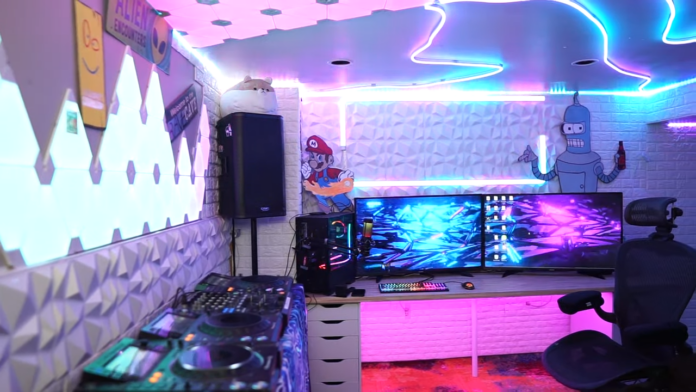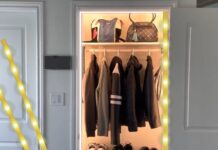Hanging LED strip lights may seem like a daunting task, but with the right tools and instructions, it can be done quickly and easily. In this blog post, we will outline the steps necessary to How To Hang Led Strip Lights Without Damaging Wall.
So, whether you’re a first-time lamp user or an experienced do-it-yourselfer, read on for all the information you need to know about hanging LED strip lights.
How I Can Led Strip Lights Without Damaging Wall:
If you want to hang led strip lights on your wall, it is important to take the proper steps to minimize any damage or scratches that may occur during installation. Here are a few tips to help you accomplish this task successfully:
1. Determine The Location:
Before you begin, it is important to take a moment to determine the ideal location for your led strip lights. It is important to consider both aesthetics and function when making this decision.
Once you have a general idea of where you would like to install your lights, use a tape measure to determine the length and width of the area. This will give you a good starting point for planning your installation.
2. Choose The Right Type Of Led Strip Lights:
There are a few different types of led strip lights available on the market, so it is important to choose the right type for your project. If you are looking for a more permanent solution, consider using adhesive-backed strips.
These strips can be applied directly to the wall using a strong adhesive. If you are looking for a temporary solution or want to be able to move your lights around easily, consider using magnetic strips.
These strips can be attached to the wall using magnets, which makes them easy to remove and reposition as needed.
3. Gather The Necessary Materials:
Once you have determined the location and type of led strip lights you need, it is time to gather the necessary materials. If you are using adhesive-backed strips, you will need a strong adhesive such as double-sided tape or construction adhesive.
If you are using magnetic strips, you will need a supply of strong magnets. You will also need a power source for your lights. Depending on the type of lights you choose, this could be a battery pack, an AC adapter, or a USB cable.
4. Prepare The Area:
Before you begin installing your led strip lights, it is important to prepare the area where they will be mounted.
If you are using adhesive-backed strips, make sure the surface is clean and free of any dirt, dust, or debris. If you are using magnetic strips, make sure the magnets will be able to adhere to the surface.
5. Install The Led Strip Lights:
Once the area is prepared, it is time to install your led strip lights. If you are using adhesive-backed strips, peel off the backing and apply the strips to the wall in the desired location.
If you are using magnetic strips, attach the magnets to the wall in the desired location. Once the lights are in place, connect them to a power source and turn them on.
What Risks Are Associated With Hanging Strip Lights:
There are a few potential risks associated with hanging led strip lights, including.
1. Damage to the wall surface:
The adhesive on some led strip lights can damage or scratch the surface of your wall. This can be avoided by careful planning and preparing your installation area, as well as choosing a type of light that is appropriate for your project.
2. Electrical shock:
If you are not careful when installing and connecting your led strip lights, there is a risk of experiencing an electrical shock. You should always wear protective gloves and carefully follow the instructions for your particular lights to minimize this risk.
3. Overheating:
The adhesive on some led strip lights can cause them to overheat if they are exposed to too much heat or sun. If you want to avoid this risk, choose a type of light that is rated for outdoor use or install your lights in a well-ventilated area.
How To Determine Best Wall Led Strip Lights:
There are several factors to consider in order to determine the best wall-led strip lights for your needs. Some of these factors include.
1. Color:
If you want your led strip lights to match the color of your walls, choose a light that is available in a variety of different colors, or select one that can easily be painted to match your wall color.
2. Brightness:
The brightness of led strip lights is measured in lumens. Choose a light with a high lumen rating if you want a bright light, or select a light with a lower lumen rating if you are looking for a more subtle light.
3. Wattage:
The wattage of led strip lights is another important factor to consider. The higher the wattage, the brighter the light will be. However, higher wattage lights also consume more energy, so be sure to choose a light that is energy-efficient if you are concerned about your electric bill.
Conclusion:
So, there you have it. Now you know how to hang LED strip lights without damaging your walls. If you’re a student or just someone who likes to change up the look of their room often, this is a must-know skill.
And if you are a business owner and are looking for a new way to light up your store or office, LED strip lighting is definitely something worth considering. Thanks for reading
FAQs:
1. Can I use glue to hang my led lights?
Answer: Yes, as long as the glue is a type that will hold the weight (such as a construction adhesive). If you’re not sure if the glue is strong enough, test it by hanging light or two from it to make sure it can handle the weight.
2. How many LED strip lights can I hang on one clip?
Answer: This depends on a few factors, including the type of LED strip light you are using and the clip itself. For example, some LED strip lights are designed for indoor use only, while others can be used both indoors and out. Some clips are designed for heavier duty.
3. How do I make sure the light is evenly distributed across the entire length of the strip?
Answer: First, make sure that the lamp is at the correct height. If it’s too low or too high, the light will be uneven. Second, check to see if the shade is blocking any of the light. If it is, adjust it so that more light can come through.




